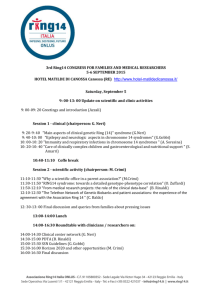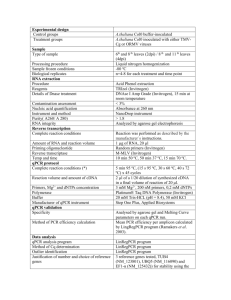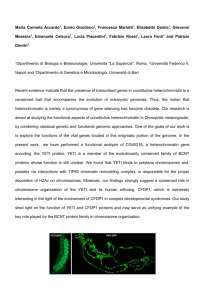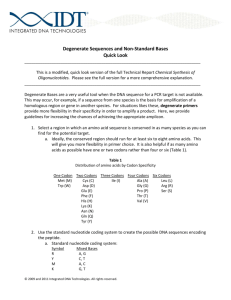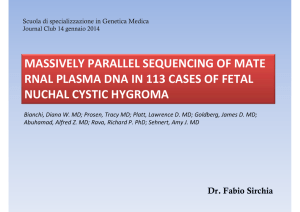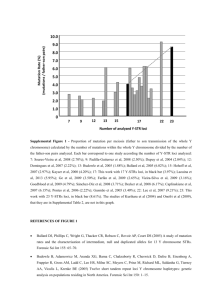Identification of a 5S rDNA spacer type specific to Triticum urartu
advertisement
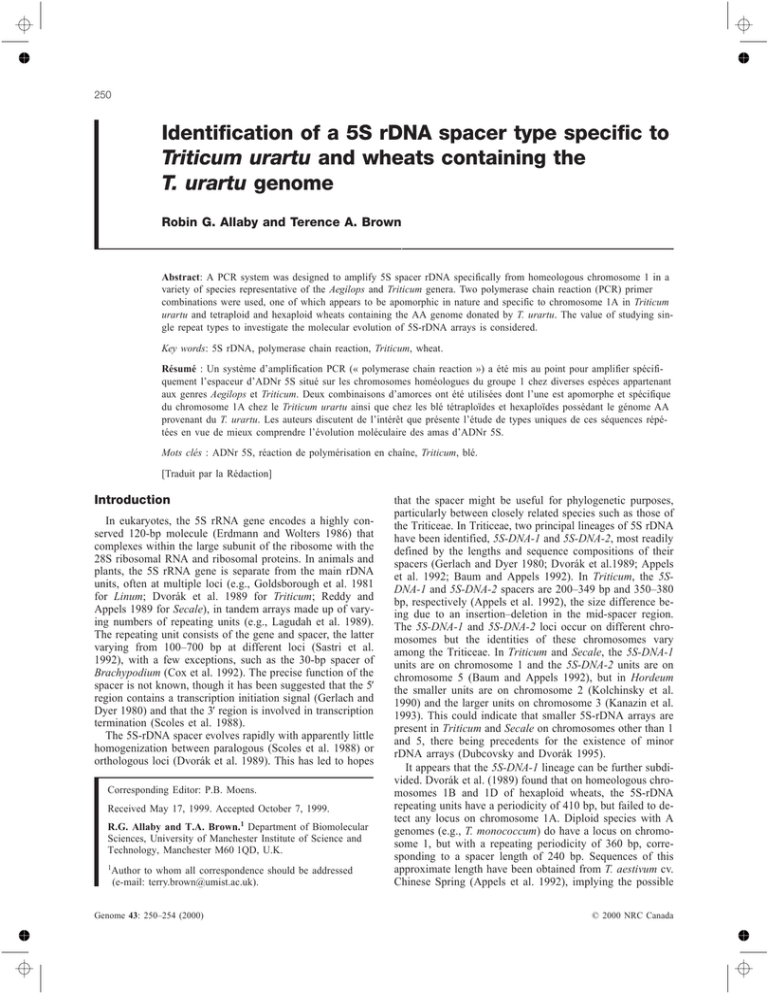
250 Identification of a 5S rDNA spacer type specific to Triticum urartu and wheats containing the T. urartu genome Robin G. Allaby and Terence A. Brown Abstract: A PCR system was designed to amplify 5S spacer rDNA specifically from homeologous chromosome 1 in a variety of species representative of the Aegilops and Triticum genera. Two polymerase chain reaction (PCR) primer combinations were used, one of which appears to be apomorphic in nature and specific to chromosome 1A in Triticum urartu and tetraploid and hexaploid wheats containing the AA genome donated by T. urartu. The value of studying single repeat types to investigate the molecular evolution of 5S-rDNA arrays is considered. Key words: 5S rDNA, polymerase chain reaction, Triticum, wheat. Résumé : Un système d’amplification PCR (« polymerase chain reaction ») a été mis au point pour amplifier spécifiquement l’espaceur d’ADNr 5S situé sur les chromosomes homéologues du groupe 1 chez diverses espèces appartenant aux genres Aegilops et Triticum. Deux combinaisons d’amorces ont été utilisées dont l’une est apomorphe et spécifique du chromosome 1A chez le Triticum urartu ainsi que chez les blé tétraploïdes et hexaploïdes possédant le génome AA provenant du T. urartu. Les auteurs discutent de l’intérêt que présente l’étude de types uniques de ces séquences répétées en vue de mieux comprendre l’évolution moléculaire des amas d’ADNr 5S. Mots clés : ADNr 5S, réaction de polymérisation en chaîne, Triticum, blé. [Traduit par la Rédaction] Allaby and Brown 254 Introduction In eukaryotes, the 5S rRNA gene encodes a highly conserved 120-bp molecule (Erdmann and Wolters 1986) that complexes within the large subunit of the ribosome with the 28S ribosomal RNA and ribosomal proteins. In animals and plants, the 5S rRNA gene is separate from the main rDNA units, often at multiple loci (e.g., Goldsborough et al. 1981 for Linum; Dvorák et al. 1989 for Triticum; Reddy and Appels 1989 for Secale), in tandem arrays made up of varying numbers of repeating units (e.g., Lagudah et al. 1989). The repeating unit consists of the gene and spacer, the latter varying from 100–700 bp at different loci (Sastri et al. 1992), with a few exceptions, such as the 30-bp spacer of Brachypodium (Cox et al. 1992). The precise function of the spacer is not known, though it has been suggested that the 5′ region contains a transcription initiation signal (Gerlach and Dyer 1980) and that the 3′ region is involved in transcription termination (Scoles et al. 1988). The 5S-rDNA spacer evolves rapidly with apparently little homogenization between paralogous (Scoles et al. 1988) or orthologous loci (Dvorák et al. 1989). This has led to hopes Corresponding Editor: P.B. Moens. Received May 17, 1999. Accepted October 7, 1999. R.G. Allaby and T.A. Brown.1 Department of Biomolecular Sciences, University of Manchester Institute of Science and Technology, Manchester M60 1QD, U.K. 1 Author to whom all correspondence should be addressed (e-mail: terry.brown@umist.ac.uk). Genome 43: 250–254 (2000) that the spacer might be useful for phylogenetic purposes, particularly between closely related species such as those of the Triticeae. In Triticeae, two principal lineages of 5S rDNA have been identified, 5S-DNA-1 and 5S-DNA-2, most readily defined by the lengths and sequence compositions of their spacers (Gerlach and Dyer 1980; Dvorák et al.1989; Appels et al. 1992; Baum and Appels 1992). In Triticum, the 5SDNA-1 and 5S-DNA-2 spacers are 200–349 bp and 350–380 bp, respectively (Appels et al. 1992), the size difference being due to an insertion–deletion in the mid-spacer region. The 5S-DNA-1 and 5S-DNA-2 loci occur on different chromosomes but the identities of these chromosomes vary among the Triticeae. In Triticum and Secale, the 5S-DNA-1 units are on chromosome 1 and the 5S-DNA-2 units are on chromosome 5 (Baum and Appels 1992), but in Hordeum the smaller units are on chromosome 2 (Kolchinsky et al. 1990) and the larger units on chromosome 3 (Kanazin et al. 1993). This could indicate that smaller 5S-rDNA arrays are present in Triticum and Secale on chromosomes other than 1 and 5, there being precedents for the existence of minor rDNA arrays (Dubcovsky and Dvorák 1995). It appears that the 5S-DNA-1 lineage can be further subdivided. Dvorák et al. (1989) found that on homeologous chromosomes 1B and 1D of hexaploid wheats, the 5S-rDNA repeating units have a periodicity of 410 bp, but failed to detect any locus on chromosome 1A. Diploid species with A genomes (e.g., T. monococcum) do have a locus on chromosome 1, but with a repeating periodicity of 360 bp, corresponding to a spacer length of 240 bp. Sequences of this approximate length have been obtained from T. aestivum cv. Chinese Spring (Appels et al. 1992), implying the possible © 2000 NRC Canada Allaby and Brown existence of a locus on chromosome 1A of cultivated wheats, although no such suggestion was made by the authors. In this study, we designed a polymerase chain reaction (PCR) system that would amplify a target specifically from the spacer region of the 360-bp repeating units to determine if a 5S-rDNA locus is present on chromosome 1A of cultivated wheats. The PCR system was then used to survey a wide range of Triticum and Aegilops accessions. Materials and methods Wheats were obtained from the Institut für Pflanzengenetik und Kulturpflanzenforschung, Gatersleben, Germany, and the Institute of Plant Science Research Collection of Wheat and Related Species, Norwich, U.K. One wheat was obtained from Dr. Glynis Jones, University of Sheffield, U.K., and one sample of DNA from Dr. Marcus Hamer, University of Manchester, U.K. Nullisomic and ditelosomic stocks of T. aestivum ‘Chinese Spring’ were obtained from Mr. Terry Miller, John Innes Centre, Norwich, U.K. Nucleic acids were extracted from grains of wheat using a modification of the CTAB (cetyltrimethylammonium bromide) protocol (Rogers and Bendich 1985) as described by Sallares et al. (1995). To design PCR primers, the sequences published by Appels et al. (1992) were aligned (Fig. 1). Two upstream primers were used, each with a 5′-extension of 10 bp containing a BamHI site. The first upstream primer (primer A) targeted a sequence present in both the 360-bp and the 410-bp repeating units; the second upstream primer (primer B) was specific for the 360-bp repeating unit. Neither primer A nor primer B had annealing sites for the longer repeating units associated with the 5S-DNA-2 lineage on chromosome 5 as shown in published sequences. The downstream primer (primer C) spanned the BamHI site within the 5S gene (see Fig. 1). PCRs were 100 µL in volume and contained 300 ng of each primer, 150 µM each dNTP, 10× buffer (Promega), 10–100 ng template DNA, and 2.5 units of Taq DNA polymerase (Promega). Cycling conditions were: 2 min at 94°C; 2× 2 min at 58°C, 1 min at 74°C, 1 min at 94°C; 2× 2 min at 57°C, 1 min at 74°C, 1 min at 94°C; 30× 2 min at 56°C, 1 min at 74°C, 1 min at 94°C; 2 min at 56°C, 8 min at 74°C. Electrophoresis was carried out at 3.33 V/cm in 3% NuSieve (FMC BioProducts, Rockland, Maine). Results The available sequence data indicated that PCRs with primers A and C should have given two products: one of 242 bp corresponding to the 5S-DNA-A1 locus, and one of 326 bp corresponding to the 5S-DNA-B1 and 5S-DNA-D1 loci. Primers B and C should have produced just a single product of 241 bp corresponding to the 5S-DNA-A1 locus. The results of PCRs with diploid species are summarized in Table 1A. We examined seven cultivated einkorns, three wild einkorns and eight Aegilops species spanning a range of genome types. All of the AA diploids gave the expected product, approximately 242 bp, after PCR with primers A and C. Unexpected products of about 400 bp were obtained with some diploid accessions, and T. urartu gave an additional product of 370 bp. All of the Aegilops species gave a product of 326 bp with primers A and C, this being the predicted size for the 5S-DNA-D1 locus, except Ae. speltoides, whose products were 370 and 400 bp. Of the diploids, only T. urartu gave a product (of approximately 241 bp) after PCR with primers B and C. 251 Tetraploid wheats of both the AABB and AAGG lineages were examined, as well as Ae. ovata, whose genomes are described as UUMoMo (Table 1B). Amplifications using the B– C primer combination gave the expected product of approximately 241 bp for all the tetraploids tested with the exception of Ae. ovata. PCRs with primers A and C gave 326-bp products with the AABB tetraploids and with Ae. ovata, sometimes accompanied by a 400-bp product. The AAGG species gave only the 400-bp product. All hexaploid wheats studied, including both the AABBDD and AAAAGG lineages, gave a 241-bp product after PCR with the B–C primer combination (Table 1C). Results with primers A and C were similar to those obtained with tetraploids; all AABBDD wheats gave a 326-bp product not seen with the AAAAGG species Triticum zhukovskyi. The latter gave a 400-bp product that was occasionally obtained with AABBDD wheats. T. zhukovskyi also gave a 242-bp product with primers A and C. Several nullisomic and ditelosomic preparations of T. aestivum ‘Chinese Spring’ were tested with the B–C primer combination (Table 1D). Stocks in which chromosome 1A was absent (N1AT1B and N1AT1D) did not yield any PCR product. The ditelosomic stock in which the short arm of chromosome 1A was present (DT1AS) and the long arm of 1A was absent gave a 241-bp product, while the stock in which the long arm of 1A was present (DT1AL) and the short arm absent not did not give any product. Discussion The results summarized in Table 1 show that the two primer pairs are specific to different 5S-rDNA repeat types, with the B–C combination only amplifying sequences from chromosome 1A of Triticum urartu and tetraploid and hexaploid wheats containing the AA genome donated by T. urartu. This is indicated by the absence of products when primers B and C were used with diploids other than T. urartu, together with the uniform occurrence of the 241bp product in these PCRs with tetraploids and hexaploids other than Ae. ovata. PCRs with nullisomic and ditelosomic stocks of T. aestivum ‘Chinese Spring’ show that primers B and C amplify sequences from the short arm of chromosome 1A in ‘Chinese Spring,’ demonstrating the existence of an rDNA locus on chromosome 1A in cultivated wheats. The consistency of the sizes of the products suggests that this sequence type is a recent apomorphism. The results support the proposal that T. urartu is the A-genome donor of both the B- and G-genome lineages of tetraploid and hexaploid wheats (Dvorák et al. 1993). The A–C primer pair gave a 326-bp product with all the tetraploids except T. araraticum and T. timopheevi (AAGG wheats), and all the hexaploids except T. zhukovskyi (AAAAGG). This product is presumably due to amplification of the 5S-DNA-B1 and (or) 5S-DNA-D1 loci, so its absence in the G-lineage wheats was anticipated. The A–C combination also gave 242-bp products with all the AA diploid wheats, although with T. urartu only a faint band could be seen after electrophoresis. The wide range of species, including members of both the Aegilops and Triticum genera, yielding this product suggests that the target sequence is an © 2000 NRC Canada 252 Genome Vol. 43, 2000 Fig. 1. Alignment of 360-bp 5S-DNA-1 units of wheat and Hordeum (Appels et al. 1992). EMBL accession numbers are Z11449, Z11450, Z11416, and Z11417 for the four T. aestivum sequences, Z411461 for T. monococcum, and Z11436 for Hordeum. Sequences were aligned with CLUSTAL W (Thompson et al. 1994). Dots show identities with the consensus sequence and dashes represent insertions–deletions. The 5S gene region is shown in bold type and the priming sites are underlined. Two variant primers (A and B) were designed to anneal to the upstream region, these primers also including a 10-nucleotide 5′ extension containing a BamHI restriction site. The site for primer A is shown in the upper sequence and the site for primer B in the second sequence from the top. The downstream primer (C) spans a naturally occurring BamHI site in the 5S-rDNA gene region. The predicted product sizes are 242 bp for primers A and C and 241 bp for primers B and C. According to the published sequence information (not shown), primers A and C should also amplify a 326-bp product from the 410-bp repeat units at the 5S-DNA-B1 and 5S-DNA-D1 loci. ancient, hence plesiomorphic, repeat type. The 242-bp product was also amplified from T. zhukovskyi, as expected because this wheat results from hybridization between T. timopheevi (an AAGG tetraploid) and a diploid AA species, probably T. monococcum (Dvorák et al. 1988; Dvorák et al. 1993). The absence of the 242-bp product after PCRs with other tetraploids and hexaploids was unexpected, especially because the primer pair had been designed to amplify products of this length from the sequences of the 360-bp repeat units reported from T. aestivum ‘Chinese Spring’ by Appels et al. (1992). A possible explanation is indicated by the results of A–C PCRs with diploid species. According to these PCRs, the short 5S-rDNA repeat is wholly or predominantly of the A–C primer type for all AA diploids except T. urartu, the latter containing short repeats of both the A–C and B–C types, though judging from the intensities of the PCR products, the A–C type has a lower copy number. The absence of a 242-bp product after A–C PCRs with tetraploid and hexaploid wheats suggests that in polyploids, the copy number of the A–C repeat type has been further diminished beyond the detecting ability of this PCR system. However, the sequences obtained by Appels et al. (1992) show that the A–C repeat type has not been completely eradicated from the array. Its replacement with the B–C repeat type provides an opportunity to study locus homogenization, and hence concerted evolution (e.g., Dover 1982). PCRs with primers A and C occasionally gave products of 300, 370, and (or) 400 bp. The sporadic occurrence of these products implies that they derive from 5S-rDNA loci that are amplified inefficiently by these primers. This is either because their arrays are relatively short, or because there are sequence variations within one or both of the priming sites. When PCRs were carried out with Triticum species, these minor products were always accompanied by a product of the expected size (either 242 or 326 bp) except for the two AuAuGG tetraploids, which gave only the 400-bp product. This result could suggest that the minor array that gives rise to the 400-bp product in T. urartu has become the predominant 5S-rDNA locus in the G-series tetraploids. According to this hypothesis, the 400-bp product obtained after PCR of the AuAuAmAmGG hexaploid T. zhukovskyi derives from the tetraploid lineage, and the 242-bp product from the T. monococcum partner in the hybridization that led to this hexaploid. Relevance to studies of 5S rDNA evolution A principal objective of comparative biology is to identify homologous structures in different organisms. In molecular evolutionary studies, the prevalence of paralogy through duplicating mechanisms, as during 5S rDNA evolution (Scoles et al. 1988), can make this objective difficult to achieve. It was noted by Gerlach and Dyer (1980), and later by Appels et al. (1992), that in Triticum the sequences of spacers in a single 5S-rDNA array are heterogeneous, varying by 2–13% with an average heterogeneity of 5%. Kellogg and Appels (1995) showed that within a single array the genes are as variable as the spacers, and that 5S rDNA variation within a species is equal to or greater than that between species, al© 2000 NRC Canada Allaby and Brown 253 Table 1. Results of PCRs. PCR product sizes (bp)c Accessiona Sourceb Genomes A and C B and C (A) Diploids T. boeoticum Boiss. subsp. aegilopoides T. boeoticum Boiss. subsp. thaoudar T. monococcum L. T. monococcum L. subsp. atriaristatum T. monococcum L. subsp. flavescens T. monococcum L. subsp. macedonicum T. monococcum L. subsp. nigricultum T. monococcum L. subsp. vulgare T. sinskajae A. Filat and Kurk. T. urartu Tum. Ae. bicornis (Forsk.) Jaub. and Spach. Ae. caudata L. Ae. comosa Sibth. and Sm. Ae. longissima Schweinf. and Muschl. Ae. mutica Boiss. Ae. squarrosa L. Ae. speltoides Tausch Ae. sharonensis Eig. IPSR 1030001 IPSR 1020009 G. Jones IPSR 1040023 Gat 432475 IPSR 1040022 Gat Schg 3 17 Gat Schg Z 16 IPSR 1050001 IPSR 1010011 IPSR 2190001 IPSR 2090001 IPSR 2110001 IPSR 2150001 IPSR 2130001 IPSR 2220001 IPSR 2140001 IPSR 2180001 Am Am Am Am Am Am Am Am Am Au Sb C M Sl Mt D S Sl 242 242 242, 242 242, 242 242 242 242, 242, 326 326 326 326 326 326 370, 326 none none none none none none none none none 241 none none none none none none none none (B) Tetraploids T. araraticum Jakubz. subsp. nachitchevanicum T. carthlicum Nevski subsp. persicum T. dicoccoides (Korn) Schweinf. T. dicoccum (Schrank.) Schulb. T. dicoccum (Schrank.) Schulb. subsp. aethiopicum T. dicoccum (Schrank.) Schulb. subsp. farrum T. timopheevi Zhuk. Ae. ovata L. IPSR 1150002 IPSR 1090001 IPSR 1060017 IPSR 1070004 IPSR 1140001 Gat Schg 5 21 IPSR 1160001 IPSR 2020001 AuG AuB AuB AuB AuB AuB AuG UMo 400 326, 400 326, 400 326, 400 326 326 400 326 241 241 241 241 241 241 241 none (C) Hexaploids T. aestivum L. T. aestivum L. T. aestivum L. T. aestivum L. T. aestivum L. ‘Galahad’ T. compactum Host. T. macha Dek. and Men. T. sphaerococcum Perc. T. vavilovi (Tum.) Jakubz. T. zhukovskyi Men. and Er. IPSR 1190291 IPSR 1190293 IPSR 1190305 IPSR 1190638 M. Hamer IPSR 1200012 IPSR 1190291 IPSR 1210001 IPSR 1230001 IPSR 1260001 AuBD AuBD AuBD AuBD AuBD AuBD AuBD AuBD AuBD AuAmG 300, 326, 300, 300, 326, 326 326 326 326 242, 241 241 241 241 241 241 241 241 241 241 (D) Nullisomic and ditelosomic stocks T. aestivum L. ‘Chinese Spring’ (parent) N1AT1B N1AT1D DT1AS DT1AL T. T. T. T. T. AuBD not tested lacks chromosome 1A not tested not tested not tested Miller Miller Miller Miller Miller lacks chromosome 1A lacks chromosome 1A long arm lacks chromosome 1A short arm 400 400 400 370, 400 400 326, 400 400 326 326 400 400 241 not tested none 241 none a The nomenclature and taxonomy of Miller (1987) is followed here. Triticum and Aegilops are retained as two separate genera for the sake of convenience. b Gat, Institut für Pflanzengenetik und Kulturpflanzenforschung, Gatersleben; IPSR, Institute of Plant Science Research Collection of Wheat and Related Species, Norwich, U.K. c Longer products were sometimes seen, presumably due to amplification of adjacent repeating units, but are not listed. though between-species variations in the gene are generally fixed at a much lower frequency than in the spacer. Consequently, 5S-rDNA coding regions are phylogenetically unin- formative and considered to be unresolvable. Appels et al. (1992) assigned spacer sequences to loci on the basis of similarity to sequences from wild progenitors, but this can not © 2000 NRC Canada 254 be done for all sequences, such as those obtained by Cox et al. (1992), due to high instances of homoplasy. Currently it is unclear how spacers could be employed for phylogenetic purposes, or indeed how evolution progresses in a 5S-rDNA array. Kellogg and Appels (1995) suggest a mechanism of 5S rDNA evolution in which selection acts on the rDNA array as a whole, a minimum number of functional gene copies being required for survival, as has been postulated for Drosophila (Schlötterer and Tautz 1994). To understand better the process of 5S rDNA evolution, it might be useful to reassess the rationale for selection of sequences for comparison. Any single organism may have several 5S-rDNA arrays, each of which is made up of multiple repeat types. Different repeat types are essentially paralogous in relation to each other, but may also pre-date the species in which they occur. Therefore, in phylogenetic analyses it might be more informative to consider single 5S-rDNA repeat types, separate from the other repeat types within an array, to increase the probability of comparing orthologs. By studying nucleotide diversity of the spacers and genes within a particular repeat type it might be possible to obtain a more accurate idea of how a 5S-rDNA array changes with time. The design of PCR systems that enable amplification products derived from different repeat types to be identified, because they are either the only products obtained with a particular pair of primers, or because the sizes of the products are diagnostic, is the first step towards this goal. Acknowledgements This work was supported by a grant from the Natural Environment Research Council. We thank Terry Miller, John Innes Centre, Norwich, and Glynis Jones, University of Sheffield, for providing wheat specimens, and Marcus Hamer, University of Manchester, for providing a sample of DNA. References Appels, R., Baum, B.R., and Clarke, B.C. 1992. The 5S DNA units of bread wheat (Triticum aestivum). Plant Syst. Evol. 183: 183– 194. Baum, B.R., and Appels, R. 1992. Evolutionary change at the 5S DNA locus of species in the Triticeae. Plant Syst. Evol. 183: 195–208. Cox, A.V., Bennett, M.D., and Dyer, T.A. 1992. Use of the polymerase chain reaction to detect spacer size heterogeneity in plant 5S-rRNA gene clusters and to locate such clusters in wheat (Triticum aestivum L.). Theor. Appl. Genet. 83: 684–690. Dover, G.A. 1982. Molecular drive: A cohesive mode of species evolution. Nature, 299: 111–117. Dubcovsky, J., and Dvorák, J. 1995. Ribosomal RNA multigene loci: Nomads of the Triticeae genomes. Genetics, 140: 1367– 1377. Dvorák, J., McGuire, P.E., and Cassidy, B. 1988. Apparent sources of the A genomes of wheats inferred from polymorphism in Genome Vol. 43, 2000 abundance and restriction fragment length of repeated nucleotide sequences. Genome, 30: 680–689. Dvorák, J., Zhang, H.-B., Kota, R.S., and Lassner, M. 1989. Organization and evolution of the 5S ribosomal RNA gene family in wheat and related species. Genome, 32: 1003–1015. Dvorák, J., di Terlizzi, P., Zhang, H.-B., and Resta, P. 1993. The evolution of polyploid wheats: Identification of the A genome donor species. Genome, 36: 21–31. Erdmann, V.A., and Wolters, J. 1986. Collection of published 5S, 5.8S and 4.5S ribosomal RNA sequences. Nucleic Acids Res. 14(Supl.): R1–R59. Gerlach, W.L., and Dyer, T.A. 1980. Sequence organisation of the repeating units in the nucleus of wheat which contain 5S rRNA genes. Nucleic Acids Res. 8: 4851–4865. Goldsborough, P.B., Ellis, T.H., and Cullis, C.A. 1981. Organisation of the 5S RNA genes in flax. Nucleic Acids Res. 9: 5895– 5904. Kanazin, V., Ananiev, E., and Blake, T. 1993. The genetics of 5S rRNA encoding multigene families in barley. Genome, 36: 1023–1028. Kellogg, E.A., and Appels, R. 1995. Intraspecific and interspecific variation in 5S RNA genes are decoupled in diploid wheat relatives. Genetics, 140: 325–343. Kolchinsky, A., Kanazin, V., Yakovleva, E., Gazumyan, A., Kole, C., and Ananiev, E. 1990. 5S-RNA genes of barley are located on the second chromosome. Theor. Appl. Genet. 80: 333–336. Lagudah, E.S., Clarke, B.C., and Appels, R. 1989. Phylogenetic relationships of Triticum tauschii, the D-genome donor to hexaploid wheat. 4. Variation and chromosomal location of 5S DNA. Genome, 32: 1017–1025. Miller, T.E. 1987. Systematics and evolution. In Wheat Breeding— Its Scientific Basis. Edited by F.G.H. Lupton. Chapman and Hall, London. pp. 1–30. Reddy, P., and Appels, R. 1989. A second locus for the 5S multigene family in Secale L.: Sequence divergence in two lineages of the family. Genome, 32: 456–467. Rogers, S.O., and Bendich, A.J. 1985. Extraction of DNA from milligram amounts of fresh herbarium and mummified plant tissues. Plant Mol. Biol. 5: 69–76. Sallares, R., Allaby, R.G., and Brown, T.A. 1995. PCR-based identification of wheat genomes. Mol. Ecol. 4: 509–514. Sastri, D.C., Hilu, K., Appels, R., Lagudah, E.S., Playford, J., and Baum, B.R. 1992. An overview of evolution in plant 5S DNA. Plant Syst. Evol. 183: 169–181. Schlötterer, C., and Tautz, D. 1994. Chromosomal heterogeneity of Drosophila ribosomal DNA arrays suggests intrachromosomal exchanges drive concerted evolution. Curr. Biol. 4: 777–783. Scoles, G.J., Gill, B.S., Xin, Z.-Y., Clarke, B.C., McIntyre, C.L., Chapman, C., and Appels, R. 1988. Frequent duplication and deletion events in the 5S RNA genes and associated spacer regions of the Triticeae. Plant Syst. Evol. 160: 105–122. Thompson, J.D., Higgins, D.G., and Gibson, T.J. 1994. CLUSTAL W: Improving the sensitivity of progressive multiple sequence alignment through sequence weighting, position-specific gap penalties and weight matrix choice. Nucleic Acids Res. 22: 4673–4680. © 2000 NRC Canada
